8 Famous Computers with a Pathetic Amount of Power
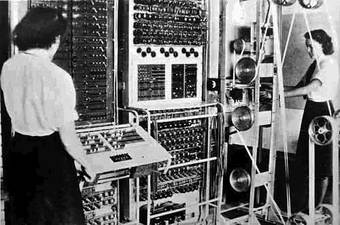 |
According to Moore’s Law, the amount of transistors that can be placed on a chip effectively doubles every two years. This means that as time goes by, computers become smaller and smaller, shrinking from the massive, room-sized computers at MIT back in the ’50s to the thin laptops and tiny cellphones in our pockets today.
It also means that computers have gotten exponentially more powerful during this same timeframe. Indeed, the power of your little handheld smartphone is now more powerful than the mightiest computers of the past, ones that cost millions to manufacture and could definitely not fit in your pocket. Here are eight of these most famous computers — the most powerful processing machines of their times — none of which would be able to run Jetpack Joyride for shit.
8) The Commodore 64
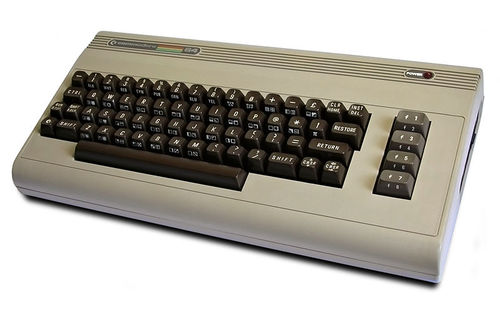 |
Sellling for $595 in 1982, the Commodore 64 was the
everyman’s (or more likely everyboy’s) computer of the 1980s. This little beige plastic number could
be used from everything from Blue Max to Castle Wolfenstein to Wizard of War,
and some productivity software in there somewhere. The clock speed was around 1
mhz. The RAM, like the name implies, was 64 kilobytes. Your modern computer
goes through resources like this in… probably a nanosecond? The standard drive on a Commodore 64
was the behemoth 1541 disk drive which ran 5.25-inch Floppies, storing an amazing
170kb of data. Your standard 1 terabyte external hard drive is probably one
fifth the size, is much, much quieter, and can store a comparable 5,882,000 warez
copies of Raid on Bungeling Bay.
7) The Original Macintosh 128k
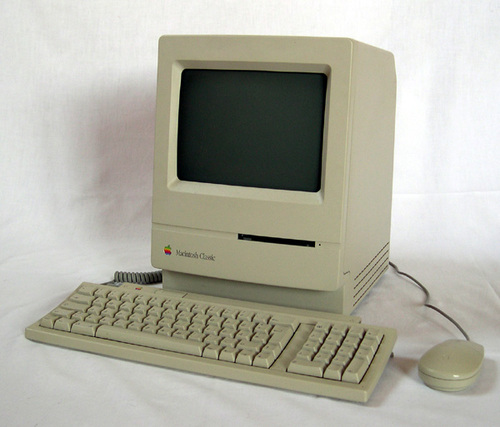 |
Well, let’s compare Apples to Apples – namely, Apple’s
original beige box, the Macintosh, as it was first released in 1984 to an
iPhone 4. This box was bout as
portable as you could get at the time.
It has a processor working at 8 MHz, so the iPhone already has a clock
speed that is 100 times faster, not considering say, improvements in bus speed,
which have been quite staggering in 30 years. The memory, as the name clearly
implies, was 128k, so the iPhone has 4,096 times more memory than this early
Macintosh computer. Ha! Take that
1984! Though they do have one
important thing in common — they will both break if you drop them on
concrete.
6) The Compaq Deskpro 386
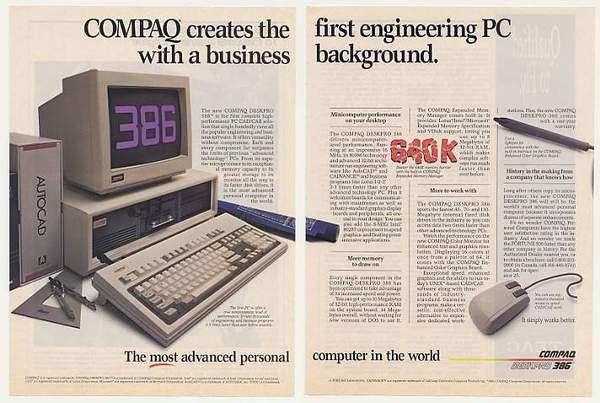 |
The Intel 386 chip was used in a variety of home PCs, but
one of the first was the Compaq Deskpro.
It came out in 1986, beating IBM to the market by several months, and
went on to be a big seller for those who hated the Macintosh/wanted to play
actual games. It was actually the
beginning of the end of IBMs dominance in making IBM-compatible computers. Costing $6,499 in 1980s dollars at
release, the computer had a 32-bit bus and a COMPLETELY ASTONISHING 16 MHz
clock speed. This was excellent
for running something like Wing Commander at 640×480 in 256 colors, which is a
frame-size and color depth we would consider to be a mistake. Still, when this came out this was
amazing. No, really, it was.
5) The Colossus
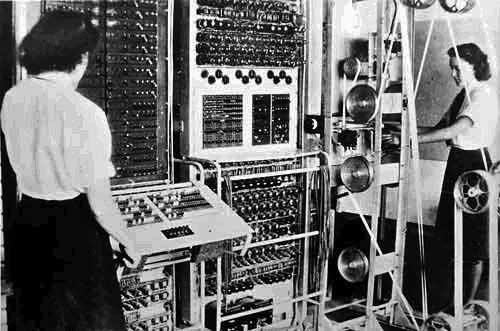 |
The Colossus was the first electronic, digital computer
built 1943 by the British Government.
It was built to win World War II, and so vital was the work this
machine did that it wasn’t declassified until the late 1970s. The main purpose
of The Colossus (of which there were several iterations, or Colossuses) was cryptography
on the German Lorenz machines used to encrypt strategic data. The Lorenz machines (of which there were
several iterations, or Lozenges) were very complex metal and rotor devices that
were super steampunk, and could generate codes that were “in theory”
unreakable. The Colossus was
dedicated to smashing this hubris. The massive machine didn’t have storage for
programs as it was reconfigured with plugs and switches to complete specific
tasks. Input of codes came rocketing through on paper tape that it read
optically — at optimal speed it would generate 5,000 characters a second,
shooting paper through at about 30mph, or about the speed of a cat unraveling
your toilet paper. Still despite this lack of power, it did help defeat the
Nazis.
4) ENIAC
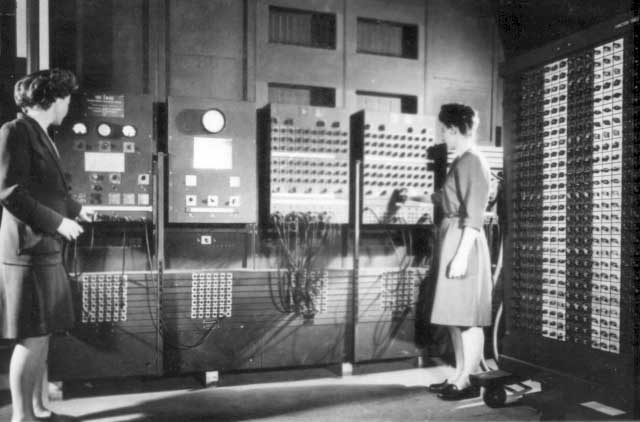 |
Built in 1946 by the United States, and sounding like some
sort of DC Golden Age supervillain, the ENIAC (Electronic Numerical Integrator
and Computer) had a “clock speed” calculated as 100 kHz, or one tenth of a MHz,
or “is that really a clock speed?” It’s really hard to exactly tell the “clock
speed though”, ENIAC didn’t really have a clock. ENIAC was really a more realistic metaphor for “The
Internets” as a giant series of thousands of tubes. Tens of thousands of tubes. It was also fragile: for example,
when your phone freezes, typically you have to pull out the battery or, at
worst hook it up to your computer and wipe it. With the ENIAC they were lucky
to have it running for a few hours without blowing out a few hundred vacuum
tubes. Further, there was no memory,
as the only data storage was punch cards — which did not store a lot of data
and had to be carefully ordered.
One of the first test runs of it involved calculations for the hydrogen
bomb which had an input/output of a million cards. That’s a lot of punching. Still, despite the work needed to make the damn thing run,
it was the first general use, programmable computer, cracking down staggering
math problems in much less time than humans could possibly do, even with an
abacus and a gallon of Red Bull.
3) The SGI IRIS Crimson
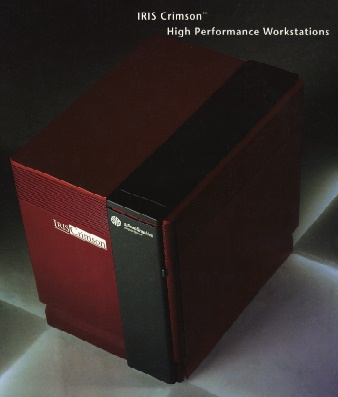 |
Code named Diehard2, it was one of the first 64 bit
workstations released around 1993.
It’s specialized chipset made it ideal for 3D animation and was used a
lot in commercial work at the time. It has a brief claim to fame a-s being seen
as the computer system used in Jurassic
Park, used to run the park itself.
Still, with all of this impressiveness it had most a 150 MHz processor,
which would cost you tens of thousands of dollars to get, and a memory maximum
of 256mb which would cost you thousands of dollars more. It did, impressively have an internal
capacity maximum 7.2 GB but that would cost you the deed to a house. Still, it
can’t play Angry Birds, so what good is it?
2) The Cray-1
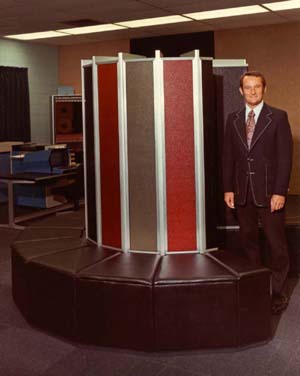 |
The Cray was pretty much with synonymous with
“Supercomputer” until the early 1990s. This first model was announced in 1975, and was a smash
hit. This crunched numbers for
everything from weather predictions to nuclear physics. It was pretty much the computer
for a long time. It ran at a clock
speed of at 80mHz. That may sound
like a pathetic amount of clock speed, but the Cray-1 had to have brand new
cooling technology developed to pump 40-tons of Freon through it to prevent it
from setting itself and the surrounding room on fire. The memory capacity on the Cray-1 was
an impressive 8mb, which would fit on a small portion of your pocket drive.
However, the Cray 1 did have a nice seating area built into it, something your
pocket drive can never have.
1) The Apollo Guidance Computer
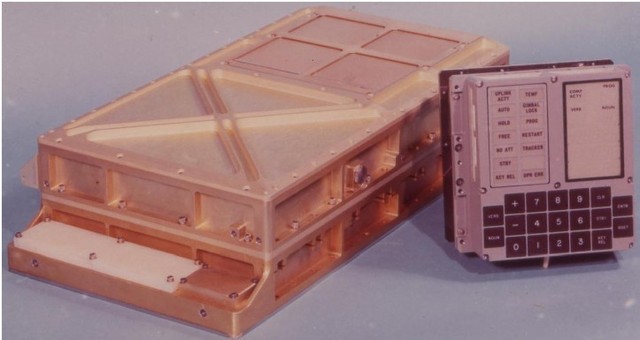 |
This was the computer that got the astronauts to the moon–TO
THE MOON. This little Wunderkind of silicon was one of the first
integrated-circuit devices, developed by MIT UltraNerds in the 1960s. This had a clock speed of 2.048 MHz.
The memory on this machine was used for storing important functions of handling
guidance, navigation and control of the lunar spacecraft was only 2k. That’s maybe just enough space to store
a Word Document in which you wrote “2k.” The storage capacity on the AGC was
read-only memory, but slightly larger at 32k. Still, it was important ROM, as it was needed to keep the
astronauts from smashing into the lunar surface from orbit. Also, of mention is that the Apollo
Guidance Computer it had to fit inside those spacecraft, so it had to be
powerful and light. “Light” being 70 lbs. The iPhone 4 is designed to fit in a pocket and is 233
times lighter at 4.8 oz. It also
comes in white! It should be
further mentioned that when it came to the actual moon landing, the AGM
suffered a huge performance degradation when a hardware bug occurred and set
off a series of alarms. Thanks to
talented nerds at mission control, they were able to recognize the alarms were
not, say, the lander about to blow up. The software on the AGM automatically reset itself to free up the
computer to actually make the crucial landing calculations, and history got
made.
